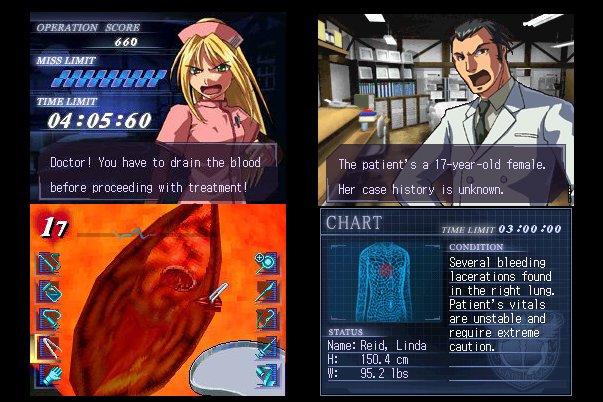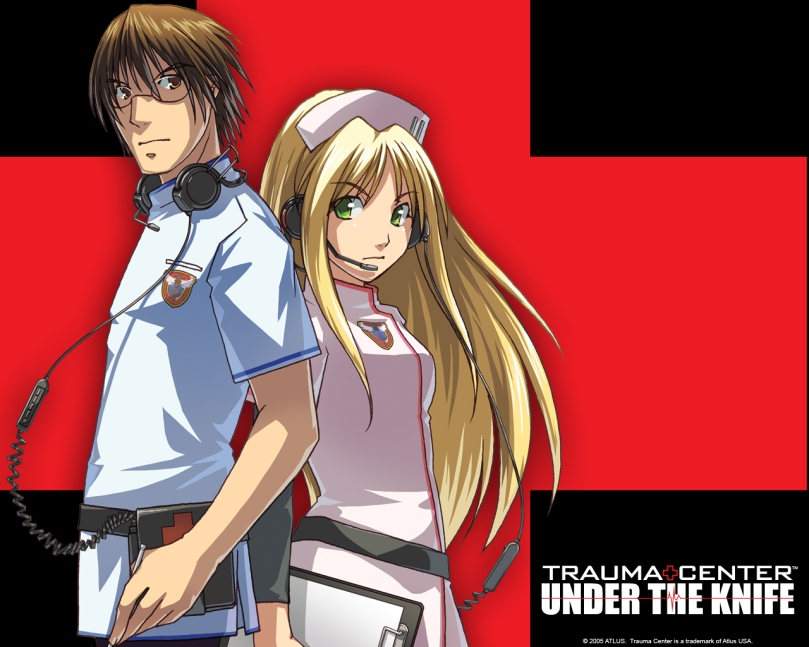I like to think I can be one of those ad-hoc surgeons they find in an emergency say on a plane after playing Trauma Center, but unfortunately I don’t have any of the surgical tools they conveniently provide for every operation in the game, so I won’t be operating on anyone anytime soon. Also, there is just the possibility that there won’t be dotted lines for me to trace on an actual human body, but let’s not think of the worst case scenarios, shall we?
This is the first time I’ve played any game in the Trauma Center series. This is a DS game, and for those unfamiliar with the capabilities of the DS, it has 2 screens, the bottom of which is touchscreen. You can probably guess which is the screen the operations are performed on. Using the stylus, you perform a variety of tasks related to cutting a person open, burning their parts with laser and frantically trying to salvage their rapidly declining vitals before they, you know, die have to be saved by a presumably more expert team of doctors.
Something I like about Trauma Center is that each operation is kept short, with a maximum time limit of 5 minutes per operation. This means that as the game progresses, the difficulty level cannot be increased by simply making operations longer and more tedious — it forces level designers to condense their design and think of more creative ways to sustain interest.
There’s an obvious pattern in the game, where an operation where they teach you new techniques is followed by a few similar operations where they don’t give you guidance. This is largely enjoyable, allowing the player to feel a growing sense of mastery, especially when operations in later chapters develop these techniques further.
The learning process itself, however, is frustrating. Learning comes in the form of your very own personal nurse (obviously female and pretty), who delivers instructions in condensed one liners. These one liners are often not comprehended by me. At the start of the game it was more often “Use the suture and stitch him back up”, which was confusing as all the tools were just silhouettes on the sides of the screen. As the game progresses and I get a better knowledge of which tools are called what, the designers have introduced tasks with strategic elements which are explained poorly perhaps because of their brevity, causing me to have to turn to walkthroughs just to get a better understanding of what was said.

Another frustration is that the delivery of the one-liners can sometimes be in the middle of the operation, which pauses time and resets the tool you are holding, and which you have to press a button in order to progress past. Since my fingers are wrapped around my stylus, it breaks the flow of the game to have to press a physical button; I’d have preferred a virtual button on the screen.
Certain operations are also not fun to go through. For example, the stage I am currently stuck at has me trying to remove “Triti” patches from a patient’s organ — except these patches keep re-growing. This race for speed turns out to be quite a chore as I find myself removing the same patches, over and over again.

Digressing from the game design to talk about the sociological slant — the main character of the game is a male doctor who starts off as being a complete slacker, ignorant of what to do and careless in his treatment. At every point of the game he is guided by a female companion, who is often a nurse. Perhaps one of the most ridiculous points of the story was when there was a bomb threat, and his fellow female doctor decides they should be the heroes to detonate the bomb — she assures him that her knowledge of bomb detonation is sound, then orders him to do the job while she assists from the side. Story-wise, it makes no sense that these female companions have superior knowledge of the operations, but end up merely assisting instead of carrying out the work themselves. Like a certain remake of Harry Potter starring Hermione as the main character, the main character in this case seems to have gotten to where he is from pure privilege… But I’m probably opening myself up to rape threats from #gamergaters.
“They ruin everything!!!”
Nevertheless, I am enjoying the game, with its many uses of the stylus on the touchscreen, as well as the story segments which provide a refreshing break in between operations.

